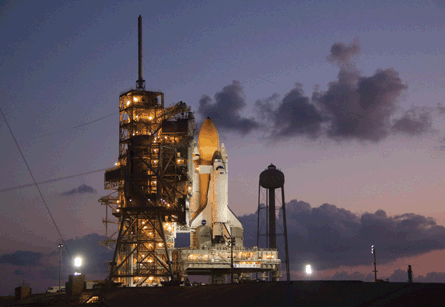After a week's worth of aborted attempts to send the Space Shuttle Discovery on its way to the International Space Station, NASA now says the earliest it will launch is 30 November. But rescheduling a Shuttle launch is no mean feat.
The soonest Discovery can be launched is 04:05 EST on 30 November, NASA says. The next launch window will last through 5 December.
One major hurdle to overcome in launch planning is timing the rendezvous with the ISS. Before the space station became the primary focus of Shuttle missions, the US space agency had two-hour launch windows, providing more options for fixing last-minute problems and waiting out bad weather. But when the Shuttle has to meet up with the space station, NASA gets only one 10-minute launch window every day.
 |
|---|
© NASA |
To keep manoeuvring - and therefore propellant consumption - to a minimum as the Shuttle races to meet the ISS in low Earth orbit NASA tries to launch as close to the middle of the 10-minute window as possible, when the Shuttle and the ISS are "in the same lane", the US space agency says. ISS's low Earth orbit also comes into play, limiting the amount of time the Shuttle has to adjust its attitude in flight. Missions to farther-flung objects like the Hubble telescope get longer launch windows.
The ISS flies over the Kennedy Space Center in Florida twice a day, although the astronauts' sleep shifts really only allow for one launch attempt a day, NASA says. Shuttle launch times are set to when the angle of the Earth's rotation will allow the Shuttle to slip into the same plane in which the ISS is flying. Those times shift about 22 minutes earlier each day, moving what was supposed to be a 16:40 flight on 1 November to a 15:04 attempted launch on 5 November - and ultimately a launch planned for 4:05 at the end of the month.
SCRUBBED
The planned 1 November take-off was repeatedly scrubbed, first to repair leaking helium and nitrogen gas lines on the Shuttle's orbital manoeuvring system pod, which took longer than expected. Then, due to electrical problems during a routine engine power-up and check-out and finally because of poor weather. The last straw came on 5 November when a hydrogen gas leak was detected while filling the external fuel tank.
The leak was at the Ground Umbilical Carrier Plate (GUCP), an attachment point between the external tank and a 178mm (7in) pipe that carries gaseous hydrogen safely away from Discovery to the flare stack, where it is burned off. Two previous shuttle missions in 2009 - Discovery's STS-119 mission and Endeavour's STS-127 - had similar problems, NASA says.
While emptying the fuel tank, engineers also discovered a foam crack on the external fuel tank's liquid oxygen intertank flange.
"We always place safety first," says NASA associate administrator for space operations Bill Gerstenmaier. "It is essential we repair this hardware before we fly the mission, and we will take the time to properly understand and fix the failure before we launch."
NASA does not expect to need the entire month of November to fix Discovery's latest ailments, but there are more scheduling hurdles than just selecting a time when it comes to Shuttle launches.
The new 30 November through 5 December launch window is "being driven almost exclusively by the solar beta cutout" that began on 8 November and will last until 23 November, NASA says. The angle of the Sun relative to the ISS changes every day. While not a problem for the station itself, it becomes a thermal problem for the Shuttle when docked with the station. When the orbiter is flying at a beta angle greater than 60e_SDgr, being hit with direct sunlight, it goes into "rotisserie" mode, rotating slowly around its X-axis. But making large rotations of the Shuttle gets complicated when it is docked at the back of the ISS - the preferred docking location since the loss of Columbia in 2003, and where the Shuttle is most protected from micro-asteroids and debris.
Other traffic to and from the ISS must also be taken into account. A Soyuz cargo flight is scheduled to depart on 29 November, and NASA prefers to not have multiple vehicles coming and going at the same time for safety reasons.
If the new, later launch window is not viable, the entire Shuttle programme will face even more scheduling challenges as it wraps up its final flights. Another solar beta cutout is coming at the start of 2011, running from 1 January to 1 February and before that, another Soyuz will arrive with three new crew members around 17 December. European and Japanese partners are also expected to make trips to ISS early in the year. The combination of events would put the next opportunity to launch at the end of February, NASA says. But that time slot has already been promised to Space Shuttle Endeavour.
Source: Flight International



















